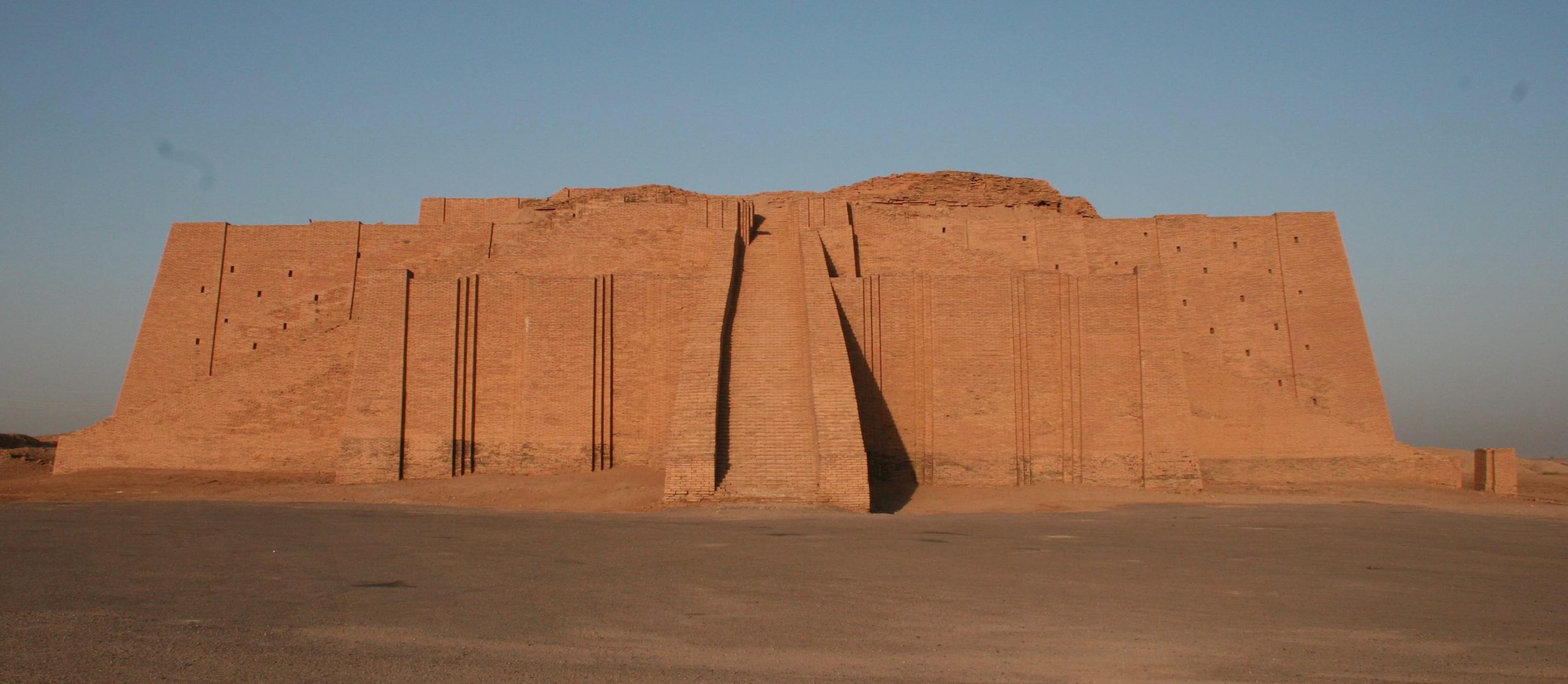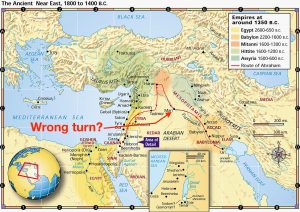Ur was not the only center of the moon-god cult in the ancient world, but it was the most important. As we noted above, the akiti festival, which was eventually celebrated for gods at cities all over Mesopotamia, probably originated at Ur sometime between 3000 and 2500 BC.
Throughout most of that millennium, other cities dominated the Fertile Crescent. After the decline of Uruk around 3100 BC (in our view, probably due to the confusion of language at Babel), “kingship” alternated between cities in Mesopotamia, including Uruk, Kish, Lagash, Mari, and Ur, down to the time of Sargon the Great.
Around 2334 BC, Sargon of Akkad established the first pan-Mesopotamian empire since the days of Nimrod (unless Sargon was Nimrod, the thesis of a new book by Dr. Doug Petrovich, Nimrod the Empire Builder), conquering and controlling an area that stretched from the Persian Gulf to the modern border between Syria and Turkey. The great king attributed his success mainly to the elder gods of the pantheon (except for Inanna/Ishtar, goddess of sex and war):
Sargon, king of Akkad, overseer (mashkim) of Inanna, king of Kish, anointed (guda) of Anu, king of the land, governor (ensi) of Enlil.[1]
But as with all kingdoms, the Akkadian Empire eventually collapsed. It was overrun by the Gutians, barbarians from the mountains of western Iran, around 2154 BC. Fifty years later, Ur-Nammu came to power in Ur. He ran the Gutians out of the land and then defeated the city-states of Uruk and Lagash. Ur-Nammu and his descendants, the Third Dynasty of Ur, controlled the entire Fertile Crescent for the next 150 years, apparently collecting tribute from as far away as Canaan.
Ur-Nammu was a builder credited with the construction of a number of buildings in Sumer, most notably the Great Ziggurat of Ur for Nanna/Sîn, the moon-god. You’ve probably seen pictures of American soldiers visiting the reconstructed step pyramid after the invasion of Iraq in 2003. Saddam Hussein rebuilt the facade and the enormous staircase of the crumbling temple in the 1980s.

Before the Gulf War erupted with “shock and awe” in 1990, it was widely reported that Saddam was rebuilding Babylon, perhaps seeing himself as a modern Nebuchadnezzar.[2] It wasn’t as well known that he also spent a lot of money reconstructing the ancient temple of Sîn. No wonder; as we’ve seen (pardon the pun), the spirit behind Babylon wasn’t Marduk—it was the moon-god.
The ziggurat of Ur was immense, measuring 210 feet long, about 150 feet wide, and at least 100 feet high. Imagine that—a ten-story building made entirely of mud brick, still standing (though in disrepair) four thousand years after it was built. The temple was called Ekishnugal, the “House of Thirty, the Great Seed,” an obvious reference to the fertility aspect of the moon-god. The massive platform that formed the base of the temple was the E-temen-nì-gùru, which means “House-foundation That Is Clad in Terror.”
Unintentionally prophetic.
The brief renaissance of Ur came to an end around 2004 BC when the Amorites, probably with help from the Elamites and Gutians, stamped out the last Sumerian kingdom in Mesopotamia. After that, for our purposes, the important centers of the moon-god shifted north and west, to the heart of Amorite country.
One of the reasons the moon-god is a focus of our study is the biblical connection between Ur and ancient Mesopotamia’s other major center of moon-god worship, Harran. That link is Abraham.
Until about a hundred years ago, when the famed archaeologist Sir Leonard Woolley excavated the fabulous Royal Tombs of Ur in the early 1920s, Bible scholars generally believed the patriarch of Jews, Muslims, and Christians had come from southern Turkey. That’s exactly where we find ancient Harran (spelled with a single r in the Bible), on the Balikh River about ten miles north of the Syrian border. In the early second millennium BC, after the collapse of the Third Dynasty of Ur, Harran was an important trading center on the caravan route between the Mediterranean coast and Assyria, in what was probably in a border zone between the Assyrians to the southeast, the Hurrians to the northeast, an emerging Amorite kingdom at Halab (Aleppo) to the southwest, and the Hittites, who were arriving in Anatolia to the northwest around that time.
Close by Harran was Ura, a town known as a home base for traveling merchants,[3] as well as cities bearing the names of Abraham’s father, grandfather, great-grandfather, and brother—namely Serug (Sarugi), Nahor (Nahur), Terah, and, of course, Haran, the father of Lot.[4] Those cities are older than the time frame of the Bible. Working backwards from the Exodus, Abraham was born around 1950 BC. That puts the births of Terah, Nahor, and Serug around 2020 BC, 2049 BC, and 2079 BC, respectively. It’s probable that Abraham’s relatives were named for those cities instead of the other way around. At the very least, their names suggest a much stronger connection between Abraham and northern Mesopotamia than with Ur in Sumer, about six hundred miles to the southeast.
Likewise, Abraham’s lifestyle as a tent-dwelling nomad is more consistent with the Amorite culture of the Levant than with Sumer. He was not a city-dweller, and neither were Isaac and Jacob. Based on Sumerian writings about the Amorites of the Syrian steppe, such a lifestyle would have been completely alien to someone raised in the sophisticated urban culture of Sumer.
And this must be said: If Abraham’s father, Terah, really meant to go from Ur in Sumer to Canaan, he wouldn’t have ended up in Harran, not even by mistake. A map of the caravan trails of the ancient Near East makes it obvious. After following the Euphrates northward from Ur, Terah would have had to miss a left turn at Mari, near the modern border between Iraq and Syria. A well-known caravan trail there crossed the steppe to Tadmor (Palmyra) and Damascus before descending into Canaan by way of Bashan, the modern Golan Heights.
Harran isn’t just a little out of the way; it’s ridiculously out of the way. Going from Ur to Canaan by way of Harran is like driving from Atlanta to Dallas by way of Chicago. It would not have happened like that.
Most important, the Bible supports this theory. When Joshua called on the tribes of Israel to remember their origins, he said:
Thus says the Lord, the God of Israel, “Long ago, your fathers lived beyond the Euphrates, Terah, the father of Abraham and of Nahor; and they served other gods. Then I took your father Abraham from beyond the River and led him through all the land of Canaan, and made his offspring many.”
Joshua 24:2–3 (ESV)
The key phrase there is “beyond the River.” Ur in Sumer is on the west bank of the Euphrates River. Abraham would not have crossed it to get to Canaan. Harran, however, is on the far side of the river. As scholar Cyrus H. Gordon argued in 1958, “it is now clear that Abraham was a merchant prince…from the Hittite realm.”[5]
Abraham was not from Sumer. He came from northern Mesopotamia and the pastoralist Amorite culture.
The moon-god’s importance in Harran is no mystery; the city was founded as a trading outpost by the kings of Ur, city of the moon-god.[6] Harran, where the deity was mainly called by his Akkadian name Sîn, sat on the main east-west route between Antioch and Nineveh. From there, traders could follow the Tigris River south to Babylon, which, as we noted above, was just beginning its rise to power in the days of Abraham.
The temple of Sîn in Harran was an important religious and political site for the Amorites of northern Mesopotamia. For example, Amorite tribes would meet at the temple of Sîn and sacrifice a donkey to ratify treaties.[7]
That wouldn’t have been weird in Syria four thousand years ago. Donkeys were sacred animals to the Amorites, and they’ve been found buried after ritual slaughter at sites all over the Near East, like Mari, Jericho, and Avaris in northern Egypt.[8] In fact, Amorite kings rode donkeys, not horses. That tradition was still alive when Jesus made His triumphal entry into Jerusalem, a point not lost on the people or the local authorities.[9]
It’s important to remember that there was no separation of church and state back then. As we’ll see, that hasn’t changed in that part of the world over the last five thousand years.
Farther west, another moon-god center is famous for being the first city conquered by Joshua west of the Jordan River. You see, the Amorite name for the moon-god was Yarikh, which is similar to the Hebrew form, yareakh. (That’s where yerakh, the old Hebrew word for “month,” comes from.) Transliterating from Semitic into English turns the y into a j, and Yarikh becomes Jericho. We’ll have more to say about Jericho in a bit.
Another site at the north end of the Jordan River Valley was also home to worshipers of the moon-god. At the southwest corner of the Sea of Galilee is Bet Yerah (“House of Yarikh” or “Temple of Yarikh”), an important center for pottery production throughout the Early Bronze Age, from about 3500 to 2300 BC.[10] Artifacts at the site and at Abydos, an ancient city on the Nile in central Egypt, confirm that Bet Yerah traded with the First Dynasty of Egypt between about 3100 and 2850 BC.[11] However, after 2850 BC, following an unidentified crisis that resulted in the abandonment of a number of sites in the Jordan Valley, Bet Yerah was resettled by migrants from the area of modern Armenia, Georgia, and Azerbaijan.[12] The new arrivals have been identified by their unique style of pottery as the Kura-Araxes people,[13] who eventually became known to history as the Hurrians,[14] the Horites of the Bible.
Around that time, a megalithic, crescent-shaped stone structure longer than one and a half football fields was built eighteen miles (about a day’s journey) from Bet Yerah. Known locally as Rujum en-Nabi Shua’ayb, or “Jethro’s Cairn,” it was finally identified in 2014 as a monument to the moon-god.[15]
So, during the Early Bronze Age, both ends of the Jordan River Valley, the Sea of Galilee and the Dead Sea, were anchored by sites occupied by worshipers of the moon-god. Although Bet Yerah had fallen on hard times by Abraham’s day, with nothing left other than a small potter’s workshop, it points to the popularity of Sîn/Yarikh among the people who lived in the region for more than a thousand years by the time the patriarch entered Canaan.
And, as we’ll see, the fallen elohim who passed himself off as the moon-god was a target of God’s wrath very early in the history of Israel.
[1] Inscription found at Nippur. Amélie Kuhrt, The Ancient Near East C. 3000–330 BC: Vol. 1 (London: Routledge, Taylor & Francis Group, 2009), p. 49.
[2] “Saddam Does Battle with Nebuchadnezzar.” The Guardian, January 4, 1999 (https://www.theguardian.com/world/1999/jan/04/iraq1), retrieved 2/7/19.
[3] Cyrus H. Gordon, “Abraham and the Merchants of Ura.” Journal of Near Eastern Studies, Vol. 17, No. 1 (Jan. 1958), pp. 28–31.
[4] Mark Chavalas, “Genealogical History as ‘Charter’: A Study of Old Babylonian Period Historiography and the Old Testament.” In Faith, Tradition, and History: Old Testament Historiography in Its Near Eastern Context (Winona Lake, Ind.: Eisenbrauns, 1994), p. 122.
[5] Gordon, op. cit., p. 31.
[6] Tamara M. Green, The City of the Moon God: Religious Traditions of Harran (Leiden; New York: E. J. Brill, 1992), p. 20.
[7] Minna Silver, “Equid Burials in Archaeological Contexts in the Amorite, Hurrian, and Hyksos Cultural Intercourse.” Aram 26:1&2 (2014), 342.
[8] Kenneth C. Way, “Assessing Sacred Asses: Bronze Age Donkey Burials in the Near East.” Levant 42:2 (2010), 214.
[9] Jack M. Sasson, “Thoughts of Zimri-Lim,” Biblical Archaeologist (June 1984), 118–119.
[10] Raphael Greenberg, Sarit Paz, David Wengrow, and Mark Iserlis, “Tel Bet Yerah: Hub of the Early Bronze Age Levant,” Near Eastern Archaeology 75:2 (2012), 90.
[11] Ibid., 95–96.
[12] Sarit Paz, “A Home Away from Home? The Settlement of Early Transcaucasian Migrants at Tel Bet Yerah,” Tel Aviv Vol. 36 (2009), 196–216.
[13] Raphael Greenberg, Sarit Paz, David Wengrow and Mark Iserlis, “Tel Bet Yerah: Hub of the Early Bronze Age Levant.” Near Eastern Archaeology, Vol. 75, No. 2 (June 2012), pp. 99-100.
[14] Marilyn Kelly-Buccellati, “Urkesh Insights into Kura-Araxes Social Interaction.” Context and Connection: Studies on the Archaeology of the Ancient Near East (Leuven; Paris; Bristol, CT: Peeters, 2018), pp. 107–123.
[15] “5,000-year-old Moon-shaped Stone Structure Identified in Northern Israel,” Haaretz, September 16, 2014 (https://www.haaretz.com/archaeology/5-000-year-old-monument-identified-in-north-1.5301928), retrieved 3/18/17.



If interested in a bird’s eye view of Jethro’s Cairn – here’s a link. Interesting. https://www.youtube.com/watch?v=_g34w96yA9k